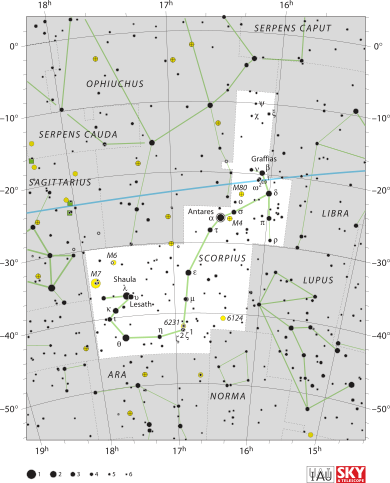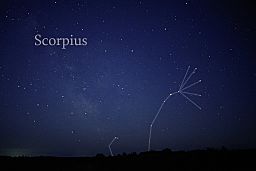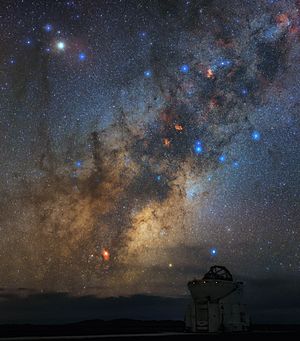Scorpius facts for kids
| Constellation | |

List of stars in Scorpius
|
|
| Abbreviation | Sco |
|---|---|
| Genitive | Scorpii |
| Pronunciation | genitive |
| Symbolism | the Scorpion |
| Right ascension | 16.8875h |
| Declination | −30.7367° |
| Quadrant | SQ3 |
| Area | 497 sq. deg. (33rd) |
| Main stars | 18 |
| Bayer/Flamsteed stars |
47 |
| Stars with planets | 14 |
| Stars brighter than 3.00m | 13 |
| Stars within 10.00 pc (32.62 ly) | 3 |
| Brightest star | Antares (α Sco) (0.96m) |
| Messier objects | 4 |
| Meteor showers | Alpha Scorpiids Omega Scorpiids |
| Bordering constellations |
Sagittarius Ophiuchus Libra Lupus Norma Ara Corona Australis |
| Visible at latitudes between +40° and −90°. Best visible at 21:00 (9 p.m.) during the month of July. |
|
Scorpius is one of the twelve constellations of the zodiac. You can find it in the Southern celestial hemisphere. Its name comes from the Latin word for "scorpion." Its symbol is ![]() (Unicode ♏).
(Unicode ♏).
Scorpius is a very old constellation. The Greek astronomer Ptolemy first officially listed it in the second century. But people knew about it long before that!
This large constellation sits between Libra to its west and Sagittarius to its east. It is located near the center of our galaxy, the Milky Way. Scorpius has 47 stars that you can see.
Contents
What Makes Scorpius Special?
Bright Stars in Scorpius
Scorpius has many bright stars. The most famous is Antares (α Sco). It's called the "rival of Mars" because it has a strong reddish color, just like the planet Mars.
Other important stars include:
- β1 Sco (Graffias or Acrab): This is actually a triple star system!
- δ Sco (Dschubba): Its name means "the forehead" of the scorpion.
- θ Sco (Sargas): We don't know where its name comes from.
- ν Sco (Jabbah)
- ξ Sco
- π Sco (Fang)
- σ Sco (Alniyat)
- τ Sco (Paikauhale)
At the very tip of the scorpion's curved tail are λ Sco (Shaula) and υ Sco (Lesath). Both their names mean "sting." Because they are so close, people sometimes call them the Cat's Eyes.
Most of the bright stars in Scorpius are part of a group called the Scorpius-Centaurus OB association. This is a group of massive, hot, and bright stars that formed together.
The star δ Sco changed in July 2000. It used to be a steady bright star, but then it suddenly got much brighter. Now, it changes its brightness over time. When it's at its brightest, it's the second brightest star in Scorpius.
U Scorpii is a very fast nova. A nova is a star that suddenly gets much brighter for a short time. U Scorpii does this about every 10 years.
You can see two stars, ω¹ Scorpii and ω² Scorpii, with your own eyes. They look like a double star and have cool contrasting blue and yellow colors.
Long ago, the star known as γ Sco is now called σ Lib. This is because the constellation Libra used to be seen as the claws of Scorpius in Ancient Greek times. Later, the Romans officially separated Libra as its own constellation.
Cool Objects in Deep Space
Because Scorpius is located right in the middle of the Milky Way, it has many amazing deep-sky objects. These include:
- Open star clusters: These are groups of stars that formed from the same giant gas cloud and are still loosely bound together. Examples in Scorpius are Messier 6 (the Butterfly Cluster) and Messier 7 (the Ptolemy Cluster).
- Globular clusters: These are much older and more tightly packed groups of stars. Messier 4 and Messier 80 are two examples.
Messier 80 (NGC 6093) is a globular cluster that is about 33,000 light-years away from Earth. It's very dense and packed with stars in its center. A rare event happened here in 1860 when a nova, called T Scorpii, was discovered within it.
Other cool objects include NGC 6302, also known as the Bug Nebula. This is a planetary nebula, which is a cloud of gas and dust formed by a dying star. NGC 6334, also called the Cat's Paw Nebula, is a place where new stars are being born.
Scorpius in Mythology
In Greek mythology, the constellation Scorpius is often linked to the story of Orion, a mighty hunter.
One story says that Orion bragged to the goddess Artemis and her mother, Leto, that he would hunt and kill every animal on Earth. To stop him, Artemis and Leto sent a giant scorpion to fight Orion. Their big battle caught the attention of Zeus, the king of the gods. Zeus decided to place both Orion and the scorpion in the sky. This was a reminder for people to not be too proud.
Another version of the myth says that Artemis's twin brother, Apollo, sent the scorpion to kill Orion. This happened after Orion had earned Artemis's favor. After Zeus put them in the sky, Orion appears in the winter sky, but he seems to run away every summer when the scorpion constellation rises. In both stories, Artemis asked Zeus to put Orion in the sky.
There's also a Greek myth where the celestial scorpion met Phaethon. Phaethon was trying to drive his father Helios's Sun Chariot across the sky.
Where Did the Name Come From?
The ancient Babylonians called this constellation MUL.GIR.TAB. This name means "the (creature with) a burning sting."
In some old descriptions, the constellation of Libra was seen as the scorpion's claws. In Babylonian and Greek, Libra was known as the "Claws of the Scorpion." The separation of Libra into its own constellation happened during Roman times.
Images for kids
See also
 In Spanish: Escorpio (constelación) para niños
In Spanish: Escorpio (constelación) para niños





